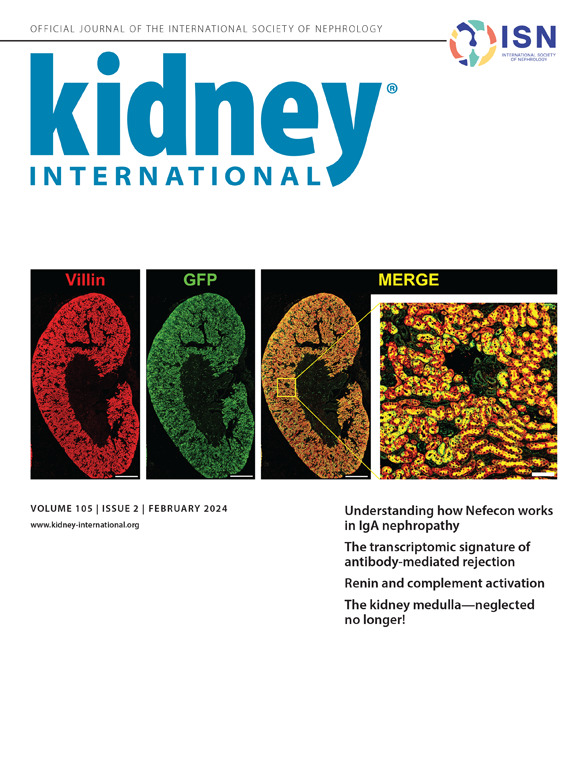分级聚类揭示了免疫复合物介导的特发性MPGN和C3肾小球病变的疾病模式和进一步解开的复杂性。
IF 12.6
1区 医学
Q1 UROLOGY & NEPHROLOGY
引用次数: 0
摘要
膜增殖性肾小球肾炎(MPGN)目前分为补体C3肾小球病(C3G)和免疫复合物介导的MPGN (IC-MPGN)。但是,分类问题仍然存在争议。在此,我们将分层聚类应用于更大的C3G/ICMPGN患者队列(295人),广泛以遗传和自身免疫补体异常为特征,目的是揭示特定的疾病模式。我们还设计了一个用户友好的web应用程序,在诊断时输入数据,使聚类分类在临床上适用。结果鉴定出5个具有独特表型和补体谱的聚类。第1组和第2组患者直到C5才出现全身性补体激活。一致地,C5肾病因子和抗因子B抗体在这些群集中普遍存在。在活检中的经典通路激活标记上,集群2与集群1区分开来。第3组显示C3限制性全身补体激活与C3肾病因子的流行相关。第4类和第5类患者具有正常的补体特征和强烈的肾小球C3染色,与固相补体激活一致,但第5类患者的遗传异常发生率较高。第4类患者在随访期间肾功能衰竭发生率最高,第1类患者肾脏预后最好。然而,集群1和2显示移植后复发的高风险。通过我们的web应用程序,我们可以直观地将新患者的预测概况与聚类分析中的患者的预测概况进行比较,并将这些患者分配到不同的聚类中。基于聚类的分类允许C3G/IC-MPGN的病因学诊断,并且比目前的方法具有更好的预后价值。结论该策略可指导抗补体治疗。本文章由计算机程序翻译,如有差异,请以英文原文为准。
Hierarchical clustering uncovered disease patterns and further untangled complexities in immune complex-mediated idiopathic MPGN and C3 glomerulopathy.
INTRODUCTION
Membranoproliferative glomerulonephritis (MPGN) is currently stratified into complement C3 glomerulopathy (C3G) and immune complex-mediated MPGN (IC-MPGN). However, classification is subject to continued debate.
METHODS
Here, we applied hierarchical clustering to a much larger cohort of patients with C3G/ICMPGN (295 individuals), extensively characterized for genetic and autoimmune complement abnormalities, with the goal of unraveling specific disease patterns. We also designed a user-friendly web application that with input of data at diagnosis could make cluster classification clinically applicable.
RESULTS
Five clusters with unique phenotypic and complement profiles were identified. Cluster 1 and 2 patients showed systemic complement activation until C5. Consistently, C5 nephritic factor and anti-factor B antibodies were prevalent in these clusters. Cluster 2 was distinguished from cluster 1 for classical pathway activation markers in biopsy. Cluster 3 showed C3-restricted systemic complement activation associated with the prevalence of C3 nephritic factor. Cluster 4 and 5 patients shared a normal complement profile and intense glomerular C3 staining, consistent with solid-phase complement activation, but cluster 5 distinguished for the higher prevalence of genetic abnormalities. Cluster 4 patients had the highest incidence of kidney failure during follow-up, while cluster 1 had the best kidney prognosis. However, clusters 1 and 2 showed a high risk of post-transplant recurrence. Through our web application, we could visually compare the predicted profile of new patients with those of patients included in clustering analysis and assign these patients to different clusters. The cluster-based classification allows etiologic diagnosis of C3G/IC-MPGN and had better prognostic value than current approaches.
CONCLUSION
Our proposed strategy may possibly guide anti-complement treatment.
求助全文
通过发布文献求助,成功后即可免费获取论文全文。
去求助
来源期刊

Kidney international
医学-泌尿学与肾脏学
CiteScore
23.30
自引率
3.10%
发文量
490
审稿时长
3-6 weeks
期刊介绍:
Kidney International (KI), the official journal of the International Society of Nephrology, is led by Dr. Pierre Ronco (Paris, France) and stands as one of nephrology's most cited and esteemed publications worldwide.
KI provides exceptional benefits for both readers and authors, featuring highly cited original articles, focused reviews, cutting-edge imaging techniques, and lively discussions on controversial topics.
The journal is dedicated to kidney research, serving researchers, clinical investigators, and practicing nephrologists.
 求助内容:
求助内容: 应助结果提醒方式:
应助结果提醒方式:


